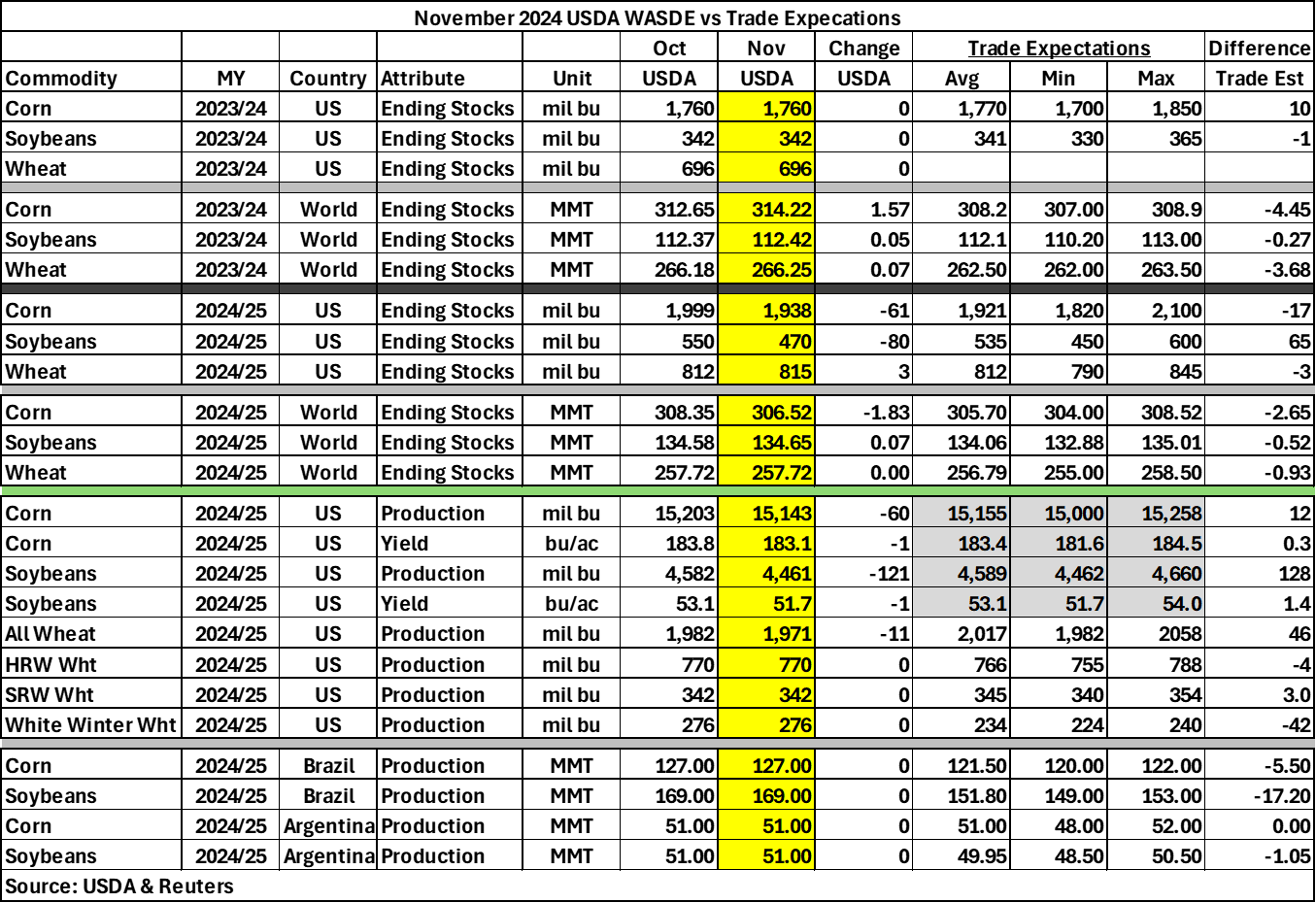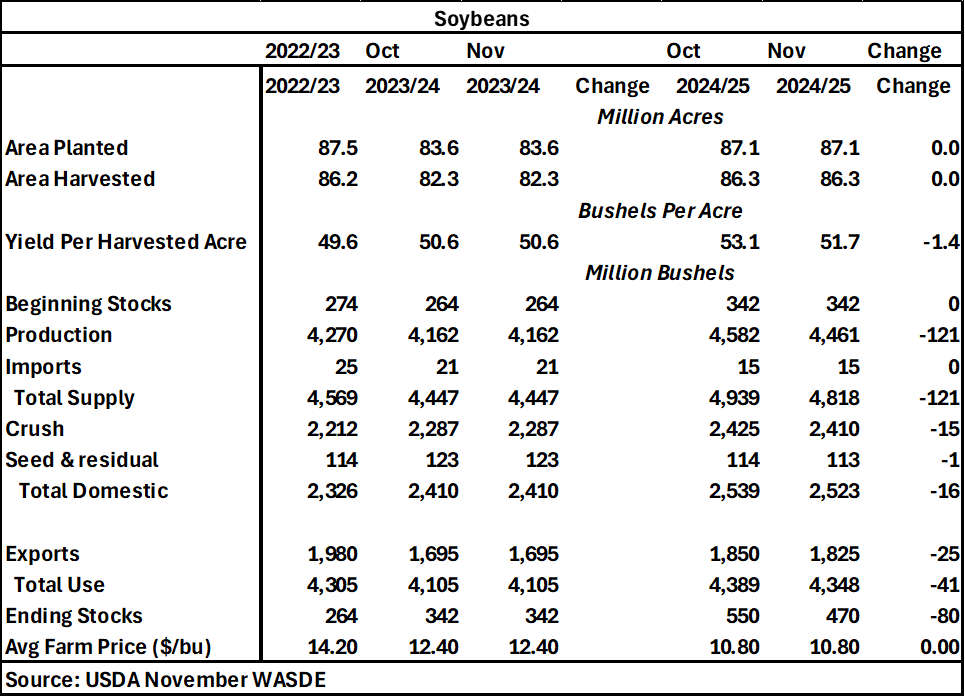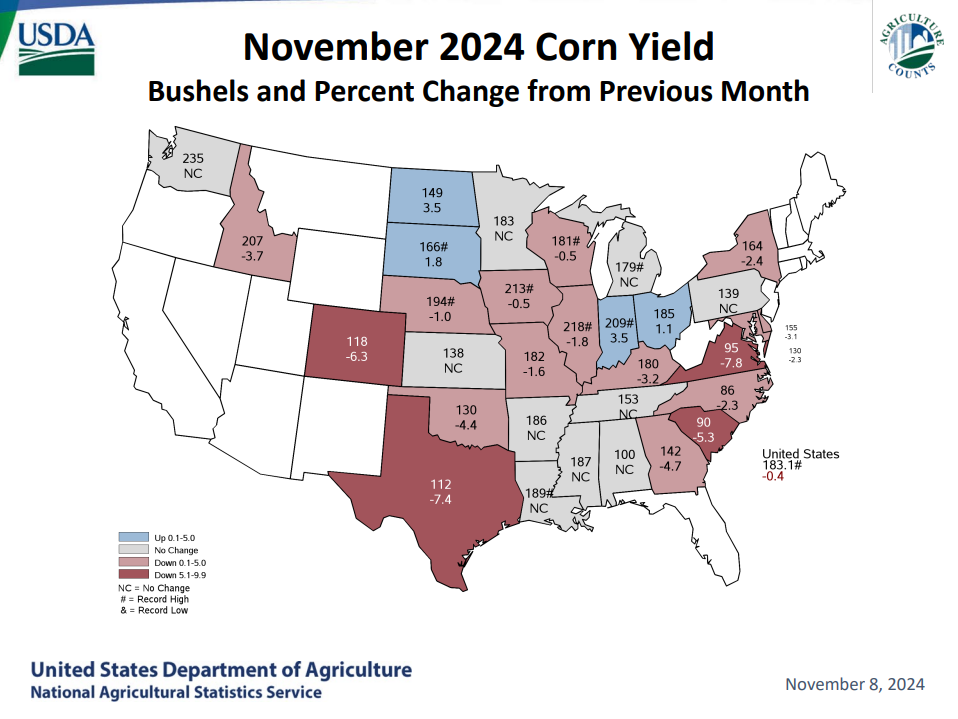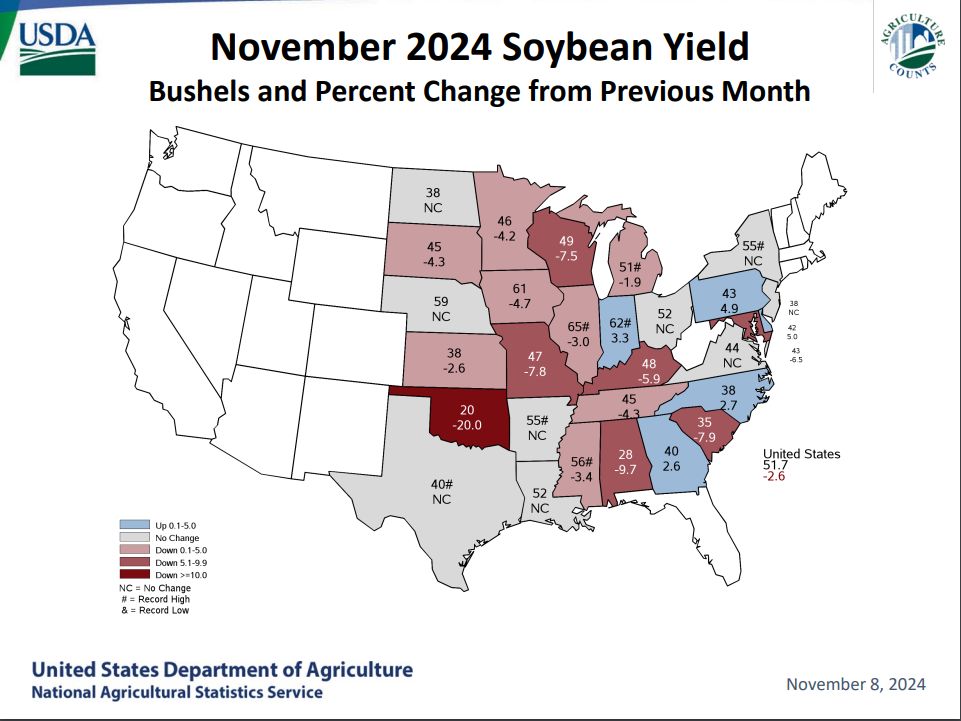WASDE Shows Decrease in US Corn and Soybean Ending Stocks in 2024/2025
Author
Published
11/11/2024
Introduction
The USDA released its updated WASDE report on November 8, 2024.
US corn, soybean, and wheat ending stocks remain unchanged for the 2023/2024 marketing year. US corn ending stocks for the 2024/2025 marketing year outperformed trade expectations by nearly 17 million bushels. Soybean ending stocks for the 2024/2025 marketing year is estimated at 470 million bushels, which is 65 million bushels less than expected. Wheat ending stocks (815 mil/bu) slightly exceeded trade expectations for the 2024/2025 marketing year.
World ending stocks for the 2024/2025 marketing year for corn, soybean and wheat all slightly exceeded trade expectations with corn seeing the largest discrepancy of 2.65 MMT.
Table 1 shows some key report estimates along with trade analyst expectations.
Table 1. November 2024 USDA WASDE vs Market Expectations

US corn production estimates decreased by 60 million bushels in the 2024/2025 marketing year and yield per acre slightly decreased by 0.7 bushels per acre. Soybean production decreased by 121 million bushels for the 2024/2025 marketing year. Total wheat production estimates decreased by 11 million bushels from October to November for the 2024/2025 marketing year.
World corn, soybean, and wheat ending stocks increased slightly by 1.57, 0.05, and 0.07 MMT in the 2023/2024 marketing year. World corn ending stocks decreased by nearly 2 MMT in the 2024/2025 marketing year, while soybeans slightly increased by 0.07 MMT and wheat remained the same in the 2024/2025 marketing year.
The USDA’s Brazil and Argentina corn and soybean production estimates remain unchanged from October to November.
Initial Market Reaction
The immediate market reaction to the USDA reports saw corn, soybean, and wheat prices increase initially before soybean and wheat prices began to fall. Corn prices reached a peak of $4.35 after the WASDE was released. March corn futures prices increased to $4.47 and were last observed at $4.44. Soybeans prices immediately increased by 20 cents to $10.30 before dropping back to $10.11. Soybean futures contracts for January, March, and May followed a similar trend. Soybean meal prices decreased by 1 cent today and soybean oil decreased by less than 1 cent. Wheat prices increased by 2 cents after the WASDE was released, before decreasing 3 cents.
Changes to Domestic Balance Sheets
For corn, production, imports, ending stocks, total supply, total domestic, and total use all remain unchanged for the 2023/2024 marketing year. For the 2024/2025 marketing year, area planted and harvested stayed constant, while yields per acre decreased by 0.7 bushels per acre. Beginning stocks stayed constant, but ending stocks decreased by 61 million bushels respectively. Production and total supply decreased by 60 and 61 million bushels respectively. Expected average farm prices remain unchanged for 2023/2024 and 2024/2025 at $4.55 and $4.10 respectively.
Table 2. November 2024 WASDE Corn Balance Sheet

For soybeans, there were no changes in the 2023/24 balance sheet. For the 2024/25 marketing year, area planted and harvested remain unchanged, but yields per harvested acre decreased by 1.4 bushels per acre to 51.7 bushels per acre. Production and total supply decreased by 121 million bushels. Total domestic, exports, and total use each decreased by 16, 25, and 41 million bushels respectively. Ending stocks decreased by 80 million bushels, while average farm price remained constant from October to November.
Table 3. November 2024 WASDE Soybean Balance Sheet

Corn and Soybean Yield Estimates
In aggregate the US corn yield forecast decreased from 183.8 bushels per acre to 183.1 bushels per acre. Changes to state yield estimates were mixed, especially across the corn belt. Iowa has an estimated 213 bushels per acre which is a 0.5% decrease from October (Figure 1). Indiana (209 bu/ac) and North Dakota (149 bu/ac) experienced the highest positive percentage in corn yield with each seeing an increase of 3.5% (Figure 1).

Figure 1. November 2024 US Corn Yield
Soybean yield estimates decreased by -2.6% nationally, with Iowa seeing a 4.7% increase to 61 bushels per acre. Indiana, Pennsylvania, North Carolina, and George were the only states to have soybean yields increase from October to November with Pennsylvania having the largest increase of 4.9% (Figure 2). Many states experienced a decrease in soybean yield, but Oklahoma, Alabama, Missouri, and Wisconsin saw much larger percent changes.

Figure 2. November 2024 US Soybean Yield
Want more news on this topic? Farm Bureau members may subscribe for a free email news service, featuring the farm and rural topics that interest them most!